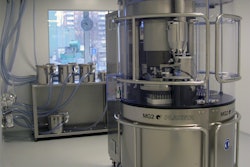1. Configuration. Where do you envision your business being five years from now and will the equipment you buy today fit with your future needs? In five years, will you require more stringent reject rates? Is speed adequate to meet your future demands? Is your capper modular and able to adapt to future needs?
2. Inline vs monobloc. Though the focus here is capping, consider the complete process. In general, a Monobloc takes up a much smaller footprint but the change parts are more expensive. Inline equipment probably will take up more space but the change parts are much more affordable. In-line equipment can handle containers larger than one 1-L and are more flexible should your requirements change over time.
3. Range of caps and containers. Needs vary greatly from a line dedicated to one container and one cap to a contract packager handling a wide range of packaging. Not all cappers can handle all caps and containers. Include in your consideration range of large to small, speed (throughput) needs for each, and specialty applications such as: CRC, CT, snap cap, rotary shaker, eye droppers, delicate, and any orientation requirements. Flexibility and modularity is the name of the game for a contract packager. You don't need to buy all the capabilities upfront if the capper can be upgraded when you have the need.
4. Container and cap tolerances. An important consideration often overlooked is cap and container quality including out-of-round, warped or oval caps, falling liner, inconsistent bottle wall thickness, and sharp edges on threads from a worn mold. It is imperative that your capper manufacturer thoroughly evaluates and tests as needed to ensure the capper will produce as quoted. Often automating a process that was done manually sheds light on other component issues where the automation solution is less tolerant to issues with caps or containers.
5. Torque control. The needs of torquing range from "I need it tight" to "All torques need to be tracked and stored.” Does the manufacturer offer the choice of mechanical clutch and servo as well as options for torque data management? Servo torque application is the most accurate means to control application torque. Constant monitoring of applied torque can prevent loose caps from continuing downstream. Can the capper guarantee no loose caps escaping the system?
6. Degree of automation (modern or dated design). How modern is the capper you're considering? Is it outdated and prone to mechanical breakdowns and repairs? Does it incorporate new technology with off-the-shelf components? Is remote servicing and programming offered? Is the capper supplied with PLC, touchscreen, job storage and retrieval? One powerful feature to look for is a capper that provides self-diagnostics. If the operator forgot to replace the worn chuck, gripper, or set air clamp pressure, will the capper alert the operator that you are not getting the desired torque repeatedly and communicate that intervention is needed?
7. Range of options available, such as customization, footprint or expandability. Why pay for a feature that is not relevant to your operation? Does your manufacturer have the experience and range of options available to tailor a machine to your specific needs? Your needs can vary for different locations or different markets, such as food, chemical, or pharmaceuticals. What are your needs for conditions, such as sanitary, washdown, or Class 1, Div 1, etc.? Specialized features could be geared towards washdown or hazardous environments. Do you need your capper to be mobile? Can your supplier reduce the footprint of the capper? What space is available and in what configuration? Can the equipment be easily enhanced or expanded with additional features down the road or to increase productivity?"
8. Integration into an existing line. How will the capper fit in to your existing operation? Do you need a standalone design for easy integration into the line? Gating options including choice of feedscrew? Does the capper need to interface with existing equipment? How disruptive will the addition of a new capper be to your line? Can the capper be installed on an existing conveyor? Is it equipped with product handling that’s compatible with your line?
9. Operation issues
• Job storage and retrieval. Is job storage included? How many jobs can be saved for retrieval? Which machine settings are automatically set up? Can you save recipes of previously run product? How many recipes? Are the setup parameters intuitive and easy to understand?
• Automation and scaled settings (set-up and changeover, ease of adjustment and operation). Which adjustments are motorized? Which adjustments are manual? Are scales provided? What indicators are included? Overall, how long does it take to set up a job? Overall, how easy is it to set up a job? How much waste of product, caps, or containers is there during set up?
How many adjustments are there? Does the capper require ongoing adjustments during the run? Are the adjustments conveniently located? Are the adjustments easy to understand and use? Set-up repeatability is key—how long will it take an operator to changeover the machine and reach “steady-state” operation?
10. Pricing issues
• Initial price. This is the other part of “How fast and how much?”question. It is a hard question to answer considering we have sold cappers ranging from $20,000 to upwards of $500,000. The key to answering this question is to determine what considerations outlined in this document are needed, including current vs future needs, features, the level of automation required, and total cost of ownership. TCO is a means to evaluate the cost of an asset not only on the initial purchase price but considering cost of operating the asset during its lifespan.
• Consumables. Certain parts will wear with time, particularly those in contact with the cap or container. Consider how many parts wear, estimate how often they’ll need to be changed, and cost. We have eliminated the cap trap gasket on some models using “Bombay” doors that will last for years.
• Container and cap designs in the future. No one can predict what will be in style years from now. Some industries, such as cosmetics and personal care, are subject to ongoing changes in cap and container design. Regardless of the industry, consider the flexibility of the capper you are considering for future needs. Think of the benefits of a capper that is flexible and able to configure to your future needs. Consider the payback of an asset that will not become obsolete due to changing needs.
• Delivery. Does the delivery timeframe quoted meet with your needs? Does the supplier carry stock machines and have the ability to respond to your delivery needs quickly?
11. Productivity issues
• Speed, but more importantly, throughput (rework or disposal costs). In a perfect world, the capper would have no rejects. The takeaway here is that the higher the reject rate, the longer it takes to fill a customer order. Running at a speed of 60 cpm for 24 hours, throughputs would be as follows for different reject rates:
0% rejects = 86,400 throughput
3% rejects = 83,808 = -2,592 = 45 min additional runtime
5% rejects = 82,080 = -4,320 = 76 min additional runtime
10% rejects = 77,760 = -8,640 = 160 min additional runtime
Rework or disposal costs probably merits a spot on the Top 10 issues, but is often overlooked or forgotten. These can be hidden costs. All cappers will have rejects, principally from three main
factors: mechanical considerations, issues with containers or caps and operator issues. Beyond the extra runtime needed to make up for the rejected containers, consider the costs associated with reworking or disposal of the product, caps, containers, and so on, in addition to labor and administrative factors.
• Reject rate—speed (throughput) discussed above dealt with the extra time to run a job. Beyond all the costs associated with rejects, what is the impact of higher reject rates on your operation? Are rejected containers reworked or discarded? If discarded, what is the cost? If reworked, what will be the cost? Are you introducing more labor to remedy failures of a poor automation solution?
On numerous occasions we have seen operators placed after cappers to correct every container exiting the capper. What features does the capper have to minimize rejects? Does the capper have a sensor to detect a missing or cross-threaded cap that will prevent torquing in the second station that otherwise could lead to a jam-up? Perfect position of the cap + perfect torque control = perfect induction sealing.
• Self diagnostics. Does the capper employ self-diagnostics to assist in troubleshooting in the event of a fault?
• Spares and wears. How do spare parts fit in with your operation? What is the impact of excessive downtime on your operation? Does the capper manufacturer offer a consumables kit and spare parts kits with the equipment quote?
12. Service issues
• Reputation of the capper manufacturer. What experience does the manufacturer have with cappers in general? What range of capper models are offered? What role do cappers play in the manufacturer’s business—are they an integral part? Do they make their own cappers? How long have they been making cappers? What reputation does the manufacturer have in the industry?
• Reputation of the capper. Can the manufacturer provide references for the capper you are considering? Is this capper a prototype? Can you see videos of it running similar product?
• Support without a service call (warranty). Is remote servicing and programming offered? What does the warranty compare with industry norms? Does the supplier offer a preventative maintenance program, training for life and regional service visits?
• Static or dynamic manufacturer? Where was this manufacturer five years ago, where are they today, and what is their vision for the future?
Your point of view
• Past experience. What experiences have you had with the different capping methods? Are you familiar with new technologies with cappers? Is it time to learn about new choices available?
• Financial restraints. What are your capital budget limitations with respect to your needs? Which is more important—initial price or a shorter ROI timeframe? Does the supplier offer financing on flexible terms?
• Workforce. What is the operator skill level? Availability? Technology? Manual to automatic operation?
Editor's note: John Brown is the Marketing & Sales Coordinator for BellatRx. He graduated from McGill University and has a technical background in electrotechnology.


























